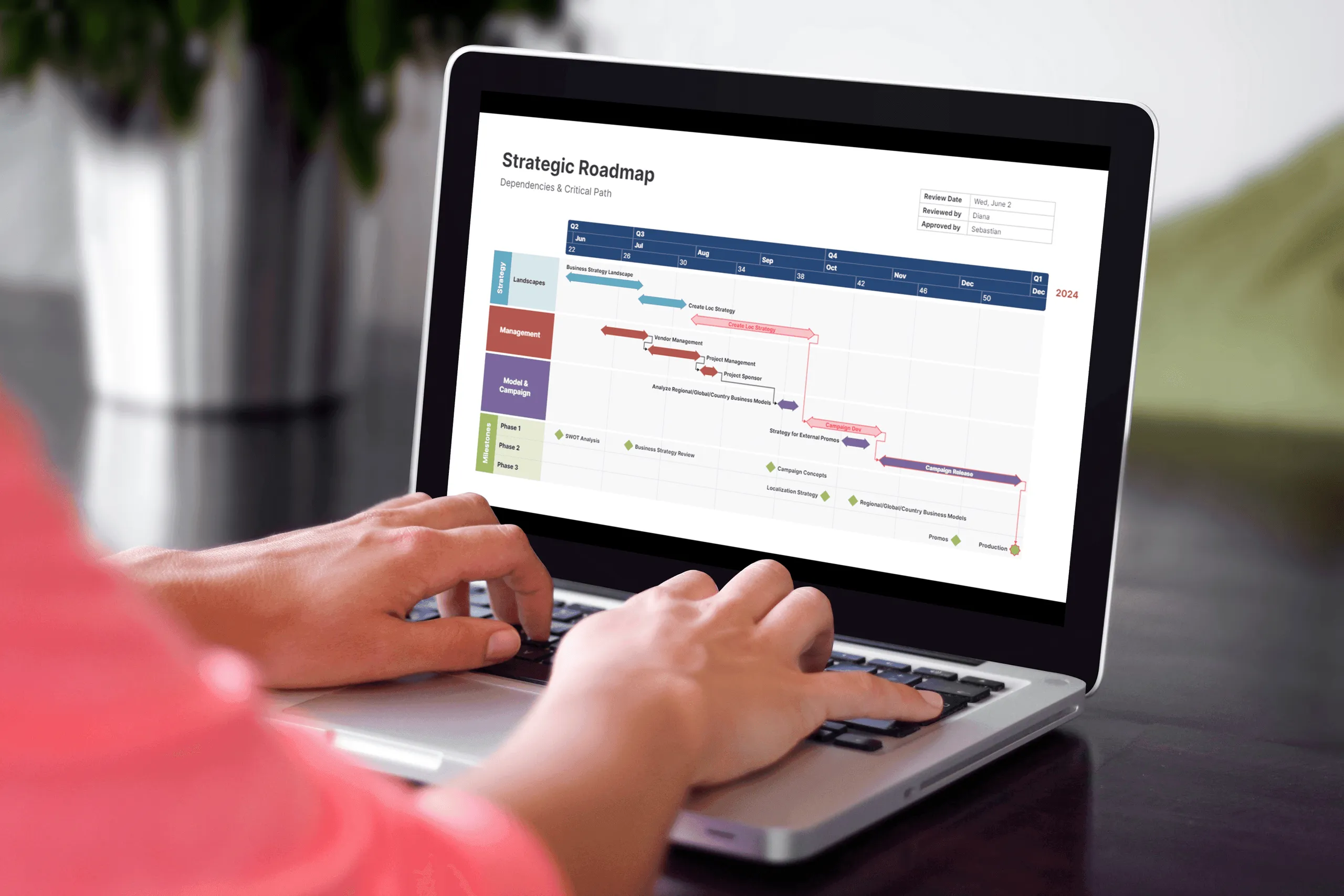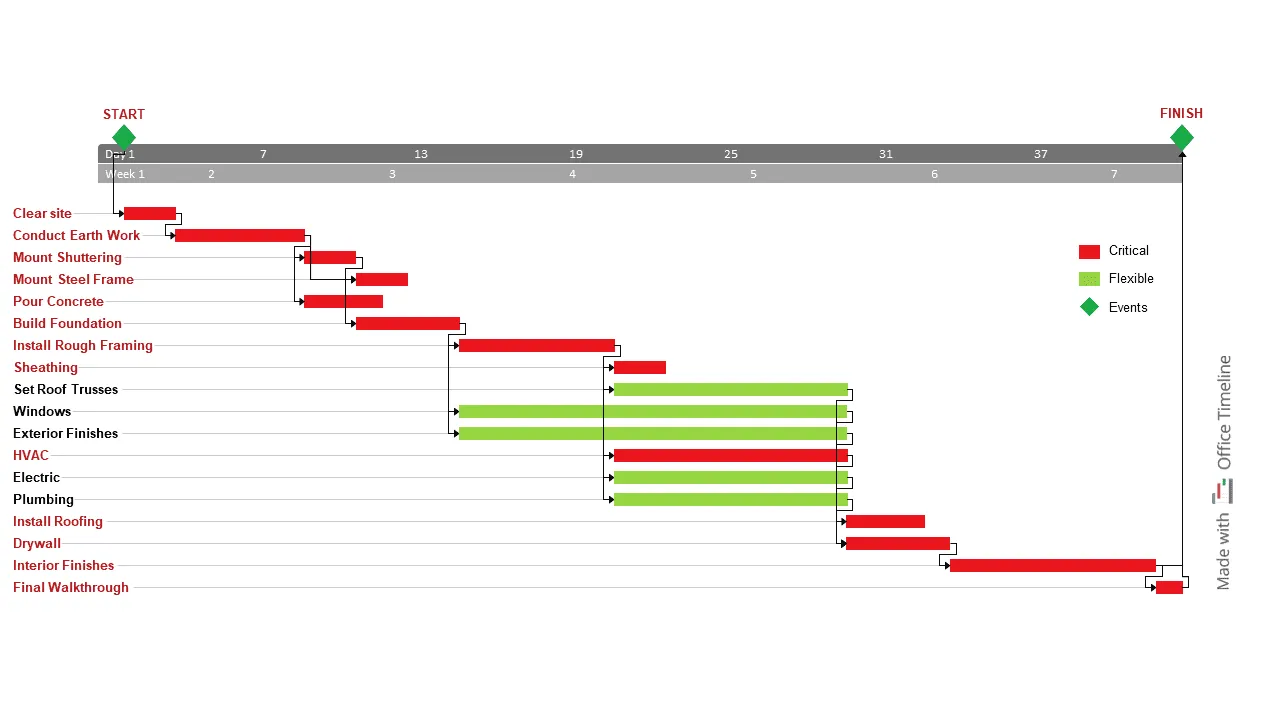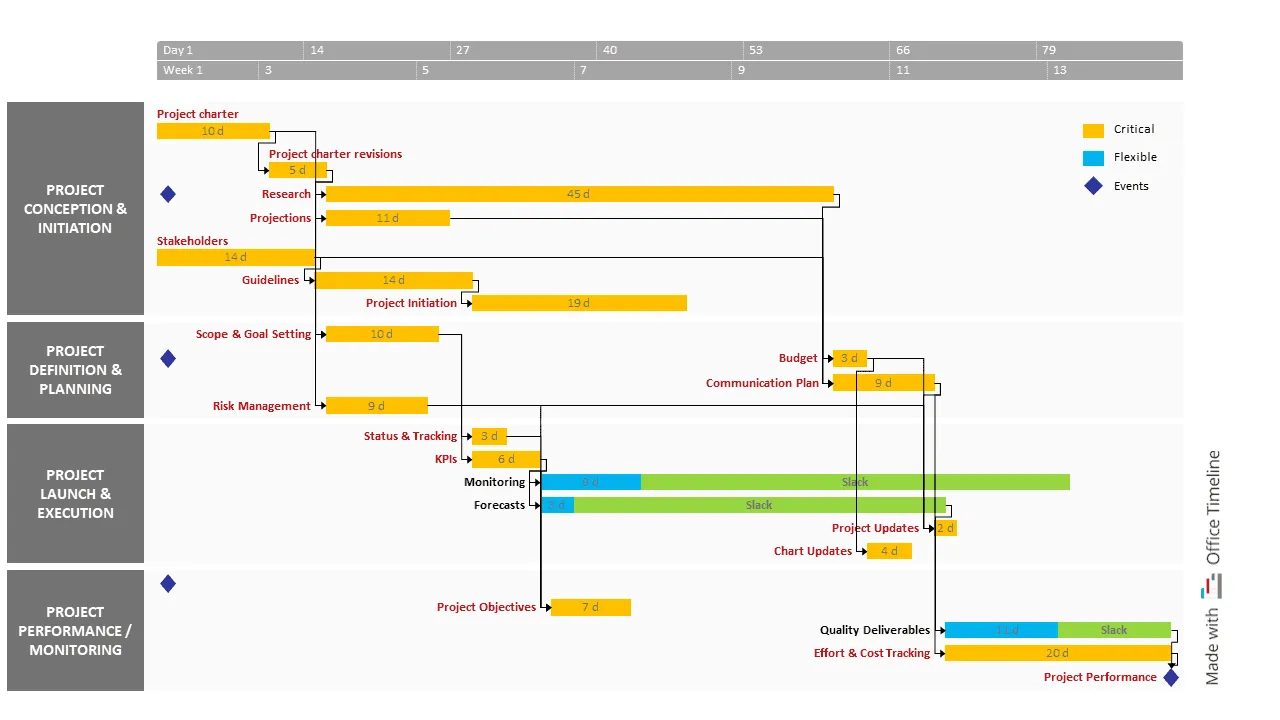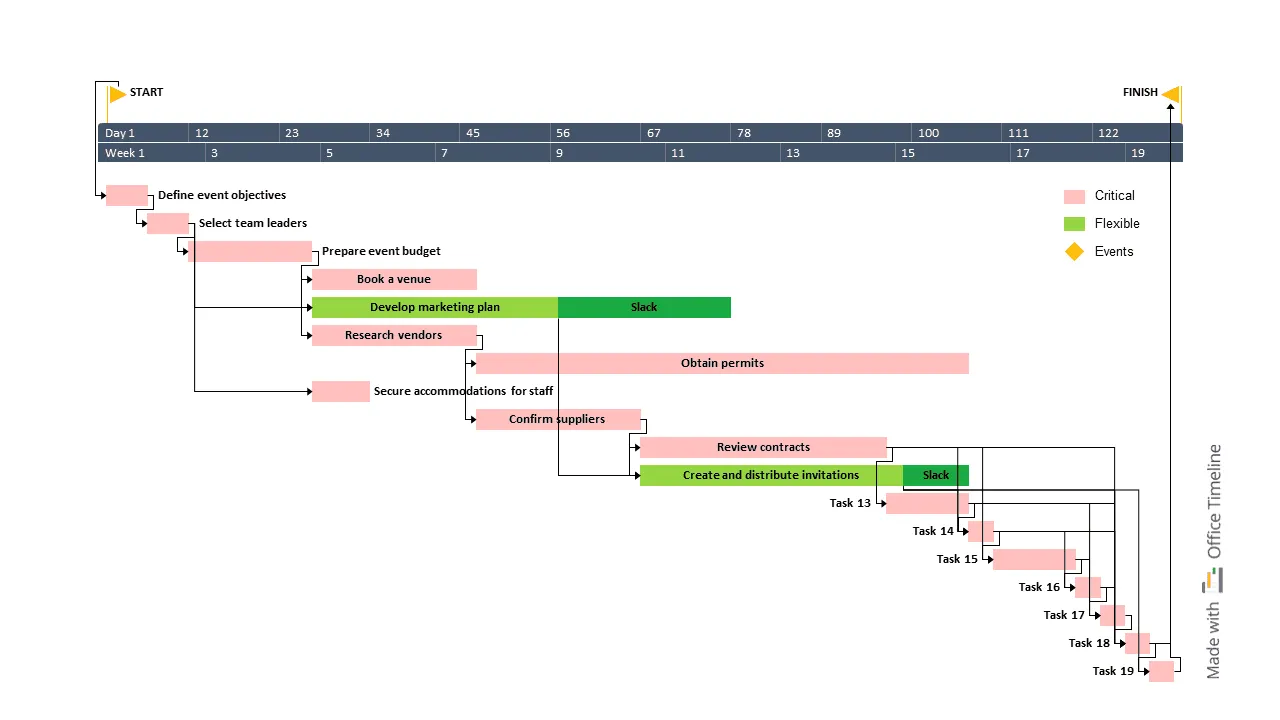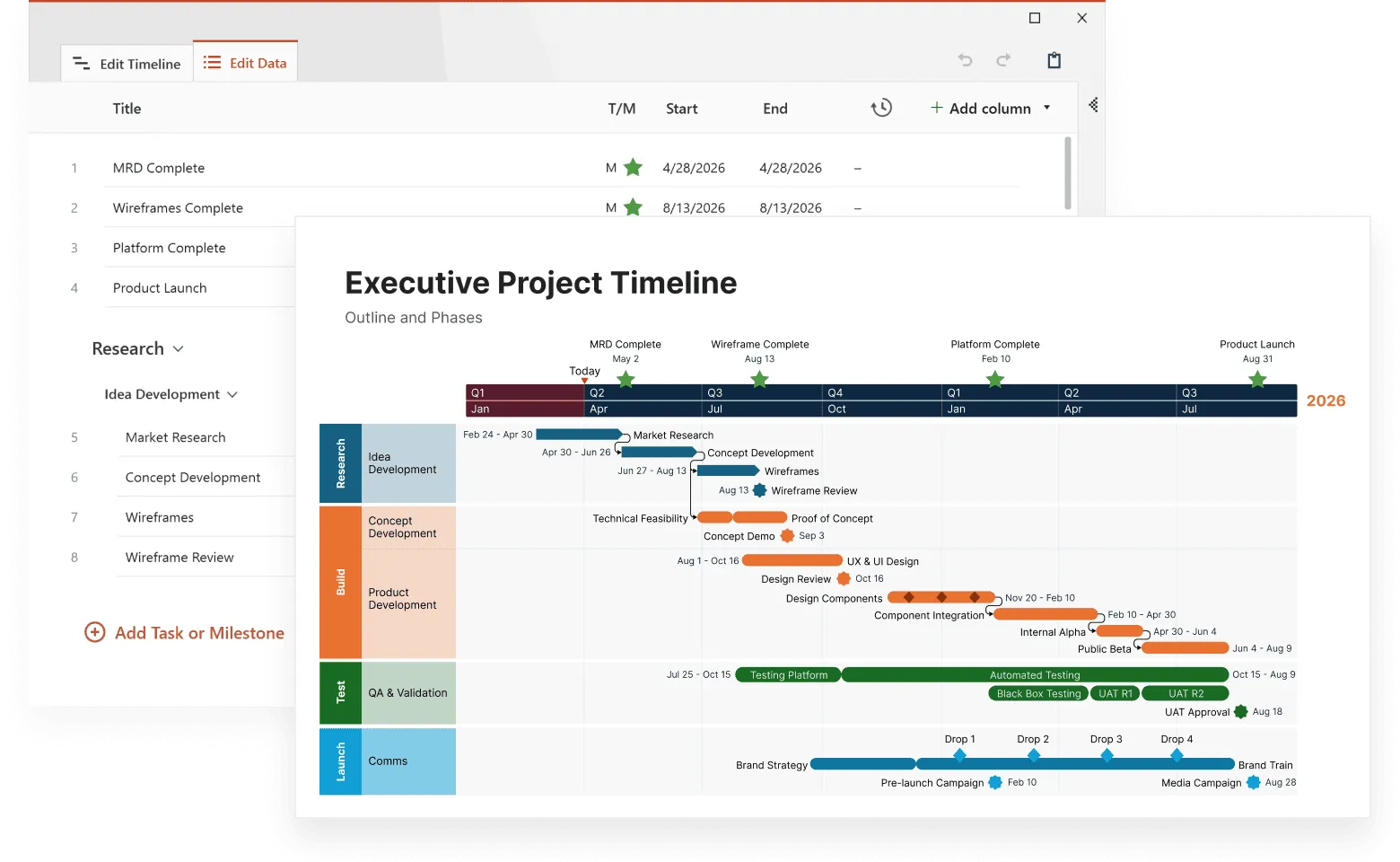What if you could identify the exact tasks that make or break your project deadline before you even start working? The Critical Path Method (CPM) does exactly that by helping you identify, right during project planning, which tasks cannot be delayed without pushing back your completion date. This scheduling technique maps out task dependencies and shows you exactly where to focus your attention to avoid delays.
CPM works by finding the longest sequence of connected tasks in your project timeline. Since these tasks have no scheduling flexibility, any delay along this path delays your entire project. Understanding this concept lets you allocate resources more strategically and spot potential problems before they derail your schedule.
The method proves especially useful for projects with multiple moving parts and complex dependencies. While CPM requires upfront planning and can be rigid when changes occur, it provides a clear framework for managing project management timelines and communicating progress to stakeholders. In this guide, we'll walk you through how CPM works, when to use it, and how to calculate your project's critical path step by step.
Why projects need structured scheduling methods like CPM
Project management means planning, organizing, and controlling work to meet specific goals within set deadlines and budgets. Whether you're building software, constructing a building, or launching a marketing campaign, project management coordinates resources and keeps work on track.
Modern projects contain dozens or hundreds of connected tasks. Some can run at the same time. Others must wait for previous work to finish. Managing these connections gets complicated fast when you're working with tight deadlines and limited resources.
The Critical Path Method solves this problem by showing you:
- which tasks must happen in a specific order;
- which delays will push back your entire project;
- where to focus your attention and resources.
Rather than tracking task connections in your head or through simple lists, CPM gives you a visual map of your project's structure. You can see exactly which tasks control your final deadline and which ones have flexibility built in.
Understanding Critical Path Method (CPM)
CPM originated during the Manhattan Project in the 1940s and was further developed in the 1950s when project managers needed better ways to handle complex, time-sensitive work. Before project management software existed, teams had to calculate critical paths manually by reviewing task sequences and identifying the longest duration path through their project network.
The method identifies the longest sequence of dependent tasks needed to complete a project. This sequence determines your minimum project duration because any delay in these tasks directly extends your completion date. Tasks on the critical path have zero flexibility - they must start and finish exactly as scheduled.
Tasks not on the critical path have some scheduling flexibility called float or slack. You can delay these tasks within limits without affecting your project deadline. This distinction helps you prioritize work and allocate resources where they matter most.
CPM works particularly well for projects with clear task dependencies and measurable durations. Construction projects, software development, manufacturing, and event planning all benefit from this approach because they involve sequential work where some activities must finish before others can begin.
Main concepts of CPM
To use CPM effectively, you need to grasp a few basic ideas that work together to control your project timeline. These concepts form the foundation of the method and determine how you'll analyze, plan, and manage your project schedule.
Understanding these basics helps you see why some tasks matter more than others for your completion date, and how small changes in one area can affect your entire project. Understanding these basics will help you make better decisions about where to put your resources, how to handle risks, and when to adjust your schedule.
Critical path and dependencies
The critical path is simply the longest chain of connected tasks in your project. Think of it like the slowest lane on a highway - everything moves at the speed of this lane. If any task on this path gets delayed, your whole project finishes late.
Task dependencies show how work connects. Some tasks can't start until others finish. For example:
- You can't paint a wall before building it.
- Testing software requires completed code.
- Getting approval needs a finished proposal.
Understanding these connections lets you plan the right work sequence.
Float
Float (sometimes called slack) tells you how much delay a task can absorb without causing problems. It's like having extra time built into your schedule.
Tasks on the critical path have zero float - no wiggle room at all. But other tasks might have days or weeks of float, giving you options when problems arise.
There are two types of float to understand:
- Free float - How long you can delay a task without affecting when the next task starts. This matters when you're managing day-to-day work and don't want to create conflicts for your team.
- Total float - How long you can delay a task without pushing back your project end date. This gives you the bigger picture of scheduling flexibility.
Working with float in project scheduling
Float calculations reveal where you have scheduling flexibility in your project. To find free float, subtract a task's early finish date from the early start date of its next task. When a task feeds into multiple activities, use the earliest start date among them.
Tasks with zero free float connect directly to the critical path through what's called a "feeding path." These deserve special attention because delays here can quickly create new bottlenecks.
Understanding float guides real scheduling decisions. When problems arise, you know exactly which tasks can absorb delays without causing larger issues. This knowledge becomes especially valuable when managing multiple projects or dealing with resource constraints.
Float changes constantly as work progresses. Here's what affects it:
- completed tasks ahead of schedule,
- unexpected delays in any activity,
- scope changes that add or remove work,
- resource conflicts that shift timing.
Update your calculations regularly to maintain accurate planning data throughout your project.
Remember that non-critical tasks still matter for project success. Having float doesn't make them unimportant - it gives you more options for when to complete them. Use this flexibility strategically rather than treating float as bonus time you can always spend.
When you need to reassign resources or handle unexpected delays, float calculations show you exactly where you have room to maneuver. You can delay some tasks to free up resources for critical work, or reschedule activities to avoid resource conflicts without affecting your deadline.
Putting it all together
These concepts create a complete picture of your project's timing constraints. When you know which tasks are flexible and which aren't, you can make smarter decisions about where to focus your attention and how to handle unexpected changes. The point is remembering that not all delays are equal - some hurt your schedule while others just use up buffer time you already built in.
Steps to calculate the critical path
Calculating your project's critical path involves six steps that help you identify which tasks need the most attention to keep your project on schedule. Each step builds on the previous one to create a complete picture of your project timeline and constraints.
Step 1: List all project tasks
Start by identifying every task your project requires. Use a Work Breakdown Structure (WBS) to break down your project into manageable components - this hierarchical breakdown helps you capture all necessary work and prevents you from missing important activities.
The WBS should include all deliverables, from major milestones down to individual tasks. Don't worry about the order yet. Focus on completeness. Having a comprehensive task list provides the foundation for accurate scheduling and resource planning.
Step 2: Determine task dependencies
Once you have your complete task list, identify how tasks relate to each other. These relationships, called dependencies, determine the sequence of your work: some tasks can start immediately, others must wait for previous work to finish and some can run in parallel.
Document these dependencies clearly. Task A might need to finish before Task B can start, or Task C might need input from both Task A and Task B. Project management software can help visualize these relationships through Gantt charts, making it easier to see how tasks connect.
Step 3: Estimate task durations
Assign realistic time estimates to each task. Base these on historical data from similar projects, expert judgment, or industry standards. When you lack past data, ask team members who have done similar work before.
Don't sugarcoat your estimates. Too optimistic? Your schedule becomes impossible. Too conservative? You waste time and money.
Consider these factors when estimating:
- Resource availability - Will your best developer be on vacation? Are materials backordered?
- Task complexity - Simple data entry takes hours, not days. Custom integrations can take weeks.
- Dependencies - Waiting for approvals or third-party deliverables adds time.
- Risk buffer - Account for unexpected issues without padding every single task.
Pro tip: Ask "What could go wrong?" for each estimate. A 2-day task might need 3 days if the API documentation is outdated or the stakeholder changes requirements mid-stream.
Start with your best guess, then adjust based on what you know about your team, tools, and project constraints.
Step 4: Create a network diagram
Build a visual map of your project using boxes and arrows. Each box represents a task. Arrows show which tasks must happen before others can start.
This isn't just about making things look pretty. The diagram reveals patterns you can't see in a simple task list:
- Parallel work streams - Tasks that can happen simultaneously.
- Bottlenecks - Single tasks that hold up multiple others.
- Critical handoffs - Where one team's delay affects everyone else.
Use color coding to track different work types or team assignments. Keep it simple - too many colors create confusion rather than clarity.
Your network diagram becomes a communication tool. Stakeholders can see project flow at a glance. Team members understand how their work connects to others.
Step 5: Perform forward and backward passes
Now for the math that makes CPM work. You'll run two calculations that show exactly how much wiggle room each task has (scheduling flexibility):
Forward pass starts at project beginning and moves toward the end:
- Calculates earliest start (ES) and earliest finish (EF) for each task.
- Shows the fastest possible timeline if everything goes perfectly.
Backward pass starts at project end and works backward:
- Calculates latest start (LS) and latest finish (LF) for each task.
- Shows the latest each task can start without delaying the whole project.
The difference between these numbers reveals your scheduling flexibility. Tasks with zero difference sit on your critical path - any delay here delays everything.
Step 6: Identify the critical path
Add up task durations for every possible route from project start to finish. The longest route? That's your critical path.
Here's why this matters: Tasks on the critical path have zero wiggle room. Delay any of them, and your entire project gets pushed back. Period.
How to spot critical path tasks:
- They have identical early start and late start times.
- They have identical early finish and late finish times.
- The math shows zero float time.
Mark these tasks clearly in your project plan. Use red highlighting, bold text, or whatever grabs attention.
Why this changes everything:
Critical path tasks get priority treatment. They need your best resources, closest monitoring, and fastest problem-solving when issues arise.
Non-critical tasks have breathing room called float. A task with 3 days of float can start 3 days late without affecting the final deadline. This flexibility lets you shift resources to critical path work when needed.
Think of it like airport connections. Miss your critical connection, and you miss your final destination. Miss a connection with a 4-hour layover? You still make it home on time.
Using CPM in project management
CPM changes how you schedule and track projects. Instead of guessing which delays matter, you know exactly where problems will hurt your timeline. The method gives you systematic planning, clear progress tracking, and smart ways to adjust when things change.
Success with CPM comes down to three things:
- Building a solid schedule upfront.
- Keeping your critical path updated as work happens.
- Managing resource conflicts without breaking your timeline.
Creating a CPM schedule
Pick project management software that handles network diagrams and calculates critical paths automatically. You want tools that update instantly when you change task times or dependencies. Easy sharing with team members? Non-negotiable.
Your software should highlight the critical path clearly. It should also show float time for other tasks - this tells you which work has flexibility.
Smart shortcuts: Many platforms offer CPM templates for common project types. Software development templates include testing phases and deployment dependencies. Construction templates show permit approvals and inspection sequences.
Templates save hours of setup time. But don't use them blindly - customize them for your specific project and company processes.
Building your schedule step by step: Enter all tasks with realistic time estimates. Define dependencies accurately - this drives everything else. Once complete, review your critical path. Does it make sense?
If something looks off, check your task durations and dependency links. A 30-minute task blocking a 2-week deliverable usually signals a setup error.
Monitoring and updating the critical path
Your critical path will change as work progresses. Here's how often to update:
- weekly for most projects;
- daily for fast-moving or high-risk work;
- immediately after major delays or scope changes.
Compare actual progress against your baseline schedule to spot problems early. When tasks take longer than estimated, see how this affects your critical path. Sometimes delays in non-critical tasks can create new critical paths, changing where you need to focus your attention.
Generate regular reports showing:
- critical path status,
- upcoming deadlines,
- tasks at risk of delay,
- float remaining for non-critical work.
Share these reports with stakeholders and team members so everyone understands current priorities and potential issues.
Handling resource constraints
Resource limitations often create scheduling conflicts that affect your critical path. When the same person or equipment is needed for multiple tasks, you may need to adjust your schedule to resolve conflicts.
Resource leveling helps smooth out resource demand over time. This might mean delaying some non-critical tasks to free up resources for critical path work, or splitting tasks to better distribute workload. The goal is maintaining your project completion date while avoiding resource overallocation.
Sometimes resource constraints force you to extend your project timeline. When this happens, look for ways to compress the schedule through:
- Fast-tracking - Overlapping sequential tasks that normally run one after another.
- Crashing - Adding resources to shorten task durations.
Focus these efforts on critical path activities where they'll have the most impact on your completion date.
Benefits of the Critical Path Method
CPM offers several concrete advantages for project managers dealing with complex, time-sensitive work. The method shows you which tasks actually control your timeline while giving you a framework for smarter resource allocation and risk planning.
Better task prioritization
CPM eliminates guesswork about which tasks need your attention right now. Once you identify the critical path, you know exactly which activities can't be delayed without pushing back your entire project. No more wondering if that bug fix or client review should jump to the front of the line.
The method shows task dependencies clearly. You can see which activities must finish before others can begin. This prevents common mistakes like:
- starting work too early (and then having to redo it);
- missing important sequencing requirements;
- creating delays through poor coordination.
When problems pop up - and they will - CPM shows you the impact instantly. Delay on the critical path? Big problem. Delay on a task with 5 days of float? Handle it next week.
This clarity helps you communicate realistic timeline changes to stakeholders instead of making vague promises about "catching up later."
Smarter resource management
CPM shows you where to put your A-team players. Critical path tasks get your best people. Tasks with built-in buffers? Perfect training opportunities for junior team members.
You'll spot resource conflicts during planning, not during execution when they cost real money. Maybe your lead developer is needed for two critical tasks at the same time. Better to know this now than discover it three weeks into the project.
Modern CPM software runs calculations automatically that used to take hours of manual work. This speed lets you test different scenarios quickly:
- What if we hire a contractor for the database work?
- Can we parallel these two development streams?
- Should we push the launch back two weeks to avoid the holiday crunch?
Better risk planning
CPM points you toward your biggest risks. Since you know which activities control your completion date, you can watch them closely and prepare backup plans.
The method also shows you where you have room to breathe. Tasks with float time give you options when other parts of the project hit snags. Need to pull your graphic designer off the marketing materials to fix a critical UI issue? The marketing work has 4 days of float - problem solved.
This flexibility becomes particularly valuable when managing multiple projects at once or dealing with resource constraints.
Common challenges and limitations of CPM
CPM delivers real benefits, but it's not perfect. Understanding these limitations helps you decide when CPM makes sense and when simpler methods might work better.
Takes time and planning
CPM demands detailed upfront work that can eat up weeks on complex projects. You need to:
- Identify every single task.
- Estimate durations accurately.
- Map all dependencies.
- Keep schedules updated as things change.
For a 3-task project? This prep work is overkill. For a 300-task project with multiple teams? The planning investment pays off.
The complexity trap
Large projects create network diagrams that look like spaghetti. Too many boxes and arrows make the schedule hard to read and harder to maintain. The visual clarity that makes CPM valuable gets buried under complexity.
Regular updates become a burden too. Miss a few schedule updates, and your critical path analysis becomes useless.
Schedules can be inflexible
CPM works best when things stay relatively stable. Task takes 3 days? Dependencies stay the same? Perfect.
But real projects change constantly:
- Client wants new features mid-stream.
- Key team member gets sick.
- Third-party delays push back integration work.
- Budget cuts force scope changes.
Each change ripples through your entire network diagram. Updating the critical path after major changes can take hours or days. In fast-moving environments, your schedule becomes outdated before you finish updating it.
May ignore non-critical tasks
CPM creates tunnel vision. You focus so hard on critical path tasks that other important work gets forgotten.
Non-critical doesn't mean unimportant. For example:
- Team training might have 2 weeks of float, but skip it and productivity drops.
- Stakeholder updates aren't on the critical path, but poor communication kills projects.
- Documentation has plenty of buffer time, but leaving it until the end creates technical debt.
CPM also misses the human side of project management. Team morale, relationship building, and organizational politics don't show up in network diagrams but often determine project success.
Tools and software for CPM
CPM software turns hours of manual calculation into seconds of automated analysis. These tools automate complex calculations, create visual diagrams, and help teams collaborate better on project scheduling.
What to look for in CPM tools
Not all project management software handles CPM well. Look for these must-have features:
- Automatic critical path calculation - The tool should identify your critical path automatically as you enter tasks and dependencies.
- Network diagram creation - Visual representation of task relationships and project flow.
- Gantt chart integration - Shows timeline and dependencies in an easy-to-read format.
- Real-time updates - Changes to one task automatically update the entire schedule.
- Team collaboration - Multiple users can view and update the project simultaneously.
Popular CPM software options
Microsoft Project is the heavyweight choice for complex projects. It handles thousands of tasks, advanced resource management, and detailed reporting. The learning curve is steep, but the functionality runs deep. Best for large organizations with dedicated project managers.
Smartsheet combines spreadsheet familiarity with project management power. Easy to learn if you know Excel. Good balance of features without overwhelming complexity. Works well for mid-sized teams transitioning from basic tools.
Office Timeline excels at creating polished timeline presentations from your CPM data. While other tools focus on planning and tracking, Office Timeline transforms your critical path analysis into executive-ready visuals. It integrates with Microsoft Project, Smartsheet, Excel, Wrike, and Jira, pulling in your task data and dependencies to create clean, professional Gantt charts and milestone summaries in PowerPoint that make even the most complex timelines instantly clear to any audience.
Monday.com focuses on visual simplicity and team collaboration. Color-coded boards make project status clear at a glance. Less powerful for complex dependency mapping but excellent for teams that need quick adoption.
Asana offers solid CPM features within a broader task management platform. Timeline view shows critical paths clearly. Free tier works for small teams, paid plans add advanced scheduling features.
Automated vs. manual calculation
Before project management software existed, teams calculated critical paths by hand. This meant listing all possible task sequences, adding up durations for each path, and identifying the longest one. A 50-task project could take days to analyze properly.
Manual calculation is error-prone too. Miss one dependency or miscalculate a duration, and your entire critical path analysis becomes wrong.
Automated tools handle these calculations in seconds. Change a task duration or add a new dependency? The software recalculates everything instantly. This speed lets you test "what if" scenarios quickly:
- What happens if we add two more developers?
- Can we finish early by working weekends on critical tasks?
- How does the delayed vendor delivery affect our launch date?
Manual calculation still helps you understand how CPM works. But for real projects with dozens or hundreds of tasks, automated tools are the only practical option.
Real-world examples of CPM
CPM works across industries, from massive construction projects to software launches and event planning. These examples show how different sectors use the method to manage complex timelines and dependencies.
Construction projects
The Hoover Dam project pioneered early CPM principles during the 1930s, coordinating thousands of workers across complex dependencies. Concrete pouring couldn't start until steel placement finished. Electrical installation had to wait for structural work. Each delay rippled through the entire timeline.
Modern construction projects face similar challenges but with better tools. A construction project might involve:
- foundation work that blocks all other activities;
- structural steel that controls when mechanical systems can begin;
- electrical rough-in that must happen before drywall;
- final inspections that determine occupancy dates.
For example, this construction schedule perfectly illustrates CPM in action. The red tasks form the critical path - any delay in "Clear site," "Conduct Earth Work," or "Build Foundation" pushes back the entire project finish date.
Software development
IT teams use CPM to manage software releases and system implementations, coordinating multiple teams across technical dependencies and regulatory requirements that must happen in specific order. Dependencies between coding, testing, and deployment phases become clear through critical path analysis.
For example, a software project requires completing Project charter and stakeholder alignment before detailed Research can begin, and finishing Guidelines and Project initiation before execution phases can start. CPM helps identify which delays will push back the launch date and which tasks have flexibility.
This software project shows how CPM handles both technical dependencies and organizational requirements. The critical path (yellow tasks) runs through project initiation, research, and core development work. Any delay in Research pushes back the other dependencies since other teams can't start detailed planning without those findings.
Event planning
Large events like conferences or product launches involve hundreds of coordinated tasks with strict deadlines. Miss a permit deadline or venue booking, and your entire event gets pushed back months.
Event planners use CPM to identify tasks that can't be delayed (like venue contracts) versus those with flexibility (like swag ordering). This helps them allocate time and budget where delays hurt most.
For example, this conference planning schedule shows how early decisions control everything else. The critical path (pink tasks) runs through Define event objectives, Book a venue, and Obtain permit - classic bottlenecks that can't be rushed or delayed.
The timeline also shows cascading dependencies typical in event planning. You can't Confirm suppliers until after Research vendors completes. Create and distribute invitations must wait for contracts to be reviewed. Each delay in the critical path pushes back multiple downstream tasks.
This visual makes it clear why venue booking delays are so damaging to event timelines.
These examples show how a professional timeline maker like Office Timeline turns complex project data into clear, easy-to-read visuals. The construction, software, and event planning schedules above show Office Timeline's strength in making critical paths visible. Color coding helps you spot critical tasks that control your deadline versus flexible tasks that have wiggle room. The clean design turns technical project information into visual stories that make sense.
Whether you're presenting to executives, updating stakeholders, or teaching team members about CPM, these examples can give you a professional starting point that saves hours of design work. Find out more on this topic, download the free templates and adapt them for your own projects in our blog article dedicated to use cases for the critical path method.
Conclusion
The Critical Path Method shows project managers exactly which tasks control their timeline. By mapping the longest sequence of connected tasks, you make smarter decisions about where to spend time, allocate resources, and spot real problems before they hurt your deadline.
CPM works across industries because it solves a universal challenge: managing complex work with tight deadlines and interconnected tasks. The method helps you see the big picture while staying focused on what actually matters for finishing on time.
Getting started takes upfront planning and learning time. But modern software handles the calculations automatically and creates clear visual diagrams. Whether you're running a small team project or large construction job, CPM improves your chances of finishing on time and on budget.
The real value isn't the math - it's the clarity. When you know which tasks have flexibility and which don't, you respond faster to problems that matter, communicate realistic timelines to stakeholders, and keep projects moving when unexpected issues arise.
Frequently asked questions about the Critical Path Method
Project managers often have questions about implementing CPM in their work. Here are answers to the most common questions about using the Critical Path Method effectively.
CPM is a project scheduling technique that identifies the longest sequence of dependent tasks in your project. This sequence determines your minimum project duration because any delay in these tasks delays your entire completion date. The method helps you focus on the activities that actually control your timeline.
Start by listing all project tasks, estimating their durations, and mapping out dependencies between them. Create a network diagram showing how tasks connect, then perform forward and backward pass calculations to find earliest and latest start times. The path with the longest total duration becomes your critical path.
Gantt charts show project tasks on a timeline but don't automatically identify which tasks are critical. CPM focuses specifically on finding the longest path through your project network. Many modern tools combine both - using CPM calculations to highlight critical tasks within a Gantt chart format.
CPM shows you exactly which tasks cannot be delayed without affecting your project deadline. This clarity helps you prioritize work, allocate your best resources to critical activities, and make informed decisions when problems arise. Without CPM, you might waste time on flexible tasks while critical work falls behind.
CPM improves task prioritization by eliminating guesswork about what needs immediate attention. It helps you manage resources more effectively by showing which tasks have scheduling flexibility. The method also helps with risk management by identifying potential bottlenecks before they cause delays.
CPM requires detailed upfront planning that can be time-consuming for complex projects. The method works best when task durations and dependencies stay relatively stable - frequent changes make it difficult to maintain accurate critical paths. There's also a risk of focusing too heavily on critical tasks while neglecting other important work.

